By Frank Jezioro
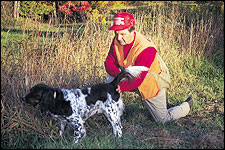 The first step is to work up to the dog until you can get your hands on him. Then with the flat of the hand push the dog forward but not so hard as to move him out of his tracks. |
"Frank, my dog is pretty staunch, but when he goes on point we need to get to him pretty quickly."
"Pretty staunch?" I was thinking as I put my 20 gauge Winchester 21 together. He wanted me to see his dog, so mine remained in the kennel while we moved into the cover. We had gone about 150 yards when my new hunting companion yelled out. "He's on point, lets go!"
I took a step and then heard something breaking brush, crashing through the tangles with sticks snapping. Then something splashed through the small stream. Must have jumped a herd of deer, a bear or maybe a bull, I thought, as I took a few more steps in the direction of where I thought the dog was. Bang! Bang!
"Damn--didn't get quite close enough before Old Blue moved a little," came an excited voice from the other side of the grapevines. Being an avid grouse hunter, breeder and trainer of pointers and setters, I get an opportunity to hunt with several different people and their dogs each year. By doing this I have noticed certain characteristics of these hunters and their dogs. When a hunter hacks at his dog to keep it within sight it is often because the hunter has no confidence in the dog and knows that the dog is not staunch. When a hunter says we need to go to the pointing dog as quickly as possible it is often because he knows it is only a matter of time before the dog will creep a few steps or charge in and flush the bird or covey.
Making a dog staunch is not a difficult task; it simply takes time and patience. Hunting with a pointing dog that will stand his birds until you arrive, no matter how long it takes, and being able to walk past him to flush the bird is the essence of hunting with a pointing dog. When a dog is truly staunch, the hunter is much more relaxed and will allow the dog to range farther, which can often result in his finding more birds.
The first step is to work the dog on a 50-foot checkcord with pigeons or quail in a launching trap. Use of a long cord allows the dog to range out and find the scent rather than have to be led to the planted bird. When working the dog toward the bird, do so by bringing him across the scent instead of taking him straight into it. Taking him across the scent cone will cause the dog to hit it hard and suddenly. Taking him straight on into the scent cone can often cause the dog to continue moving, even creep, as he realizes the closer he gets the stronger the scent becomes.
Once he establishes a solid point, tighten the checkcord just enough to let him feel the pressure, which lets him know he is under your control. Now you "walk up" the rope, maintaining tension until you reach the dog. If he lunges ahead, jerk him back, at the same time flushing the bird. Now take him out of this area and work him into another bird in another section of your training area (I usually set up three to four birds in the training area for each session). Repeat this until you are able to reach and put your hands on the dog without him lunging forward.
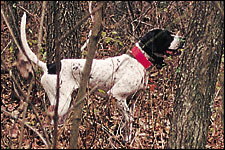 Next you push him forward while stroking his tail up and pushing the hair on his back forward, against the grain, while reassuring him with a soft "whooaa." |
Once you can put your hands on the dog, half the battle is won. While you keep the tension on the rope with one hand you take the flat of your other hand and push forward on his rear, just below his tail. You don't want to push him out of his tracks, or off of his feet, but instead just to the point where you can feel him pushing back a little. Even though he may want to pounce on the bird, he'll resist you pushing him because you are also holding the rope and he feels the pressure. Once you feel him pushing back you can alternate your pushes with strokes of his tail. Push him a little and then stroke his tail up to a 12 o'clock position. All the while, the only word you are saying is a soft, drawn out, "whooaa."
Alternate two or three seconds of pushing with the same amount of stroking. ln the early sessions make the dog stand there only 30 seconds or so before rewarding him with the flush. In these first sessions I will let the young dog chase the bird to the end of the check cord then bring him back and tell him what a great dog he is going to be. Repeat the procedure with the rest of the birds you have set out. Soon the dog will run a short distance, knowing that if he doesn't stop he will feel the jerk of the cord, if he continues with the chase.
In a few days the dog will stand there waiting for you to reach him. Once the dog knows what to expect, which is gentle, loving handling and stroking, he will be looking forward to your arrival. Dogs like to be handled while on point once they know what is coming. The dog should be hitting his points now on his own and holding until you reach him. For the first few times, until you are sure, let him drag the cord but don't hold it. It is simply a precaution at this point. Once he points walk over, step on the cord and just walk up the rope to the dog's side. Here you can use a helper if one is available. They will be off to the side, at the other end of a long string that can launch the bird should the dog have a little lapse in standing there.
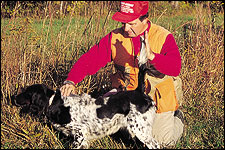 Suspense and excitement come when you spend a few moments searching for and then finding your staunch dogs locked on point with birds pinned in front of them. |
After a week or so the real reinforcement comes into play. The dog is standing now waiting for you to stroke and push him forward. Soon you will notice him leaning back before you actually get to him. This is what you have been seeking. Now he is more interested in leaning back than moving forward, as he knows eventually you will flush the bird for him. This time when you get to him push him and stroke him a little. Then put your hand under his rear and raise him off of the ground putting him into a position that resembles a dog doing a handstand. Drop him gently and stroke him and push him again. Again lift his rear off of the ground and shove forward a little as he stands only on his front legs. As you drop him you will notice him coming down stiff legged, sort of in slow motion, only to remain on point. Repeat this a few times and flush the bird for him.
The next step is to p
ick up his rear and turn him in a half circle, as if you are trying to make a "U" out of him. Again drop him and you will see that he hits the ground bent double, as if stepping on eggshells, but still looking in the direction of the scent and standing on point. Stroke and push him forward again. Also start in front of his tail and push the hair on his back forward, sort of against the grain, all the way to the back of his head. This also will make him resist moving forward and cause him to sit back toward the forward pressure.
Do this for a few days and then when you reach him stroke him, push him, lift and drop him, lift, turn him and drop him as you have in the past. Now that you can tell he is accepting this program you want to put one hand under his chest and one under his rear and lift him completely off of the ground. Toss him forward about a foot and he will hit the ground on point again. Stroke him, push him, lift and drop him until he settles in again. Pick him up again and toss him forward a little further. Do this entire procedure three or four times and then the last time you toss him forward have your helper flush the bird. Scold him softly as you move him back to where you last lifted him off of the ground. Repeating this will cause him to lean back when hitting the ground as he begins to realize that if he goes forward the bird will be flushed and he will be chastised.
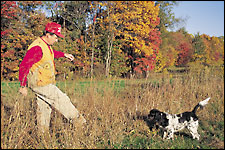 Lift the dog's hind legs off of the ground and drop him. Then lift him again turning him as if making a "U" out of him and drop him again. He will hit the ground still on point and looking in the direction of the scent. |
To this point you have been working alongside the dog. Now it is time to move past him. Walk up to him do the entire procedure again only this time move a step past him while putting the flat of your hand in front of his face. Give him a sharp "whoa" at the same time you raise your hand sharply, high above your head. Every time you take a step thrust your hand up in front of him while you give him the sharp whoa command. This gets his attention and later you will be able to stop him by simply raising your hand sharply as he is watching. Face him as you walk backward a few steps in front of him. If you see him tensing up thrust your hand high in the air and repeat the whoa command. Walk toward him a step or so while you kick at the grass around the planted bird. Do this for a minute for so then walk back beside him. Stroke him and flush the bird.
In this last step, you repeat everything you have done in the past. Once on point you walk up to him, stroke and push him forward, push the hair forward on his back, lift his rear until he is doing a hand stand and drop him. Then lift him again, twist him and drop him. Lift him off of the ground a foot or so and toss him forward a couple of times but not too close to the bird. Walk backward in front of him, facing him as you thrust your hand into the air while you give him a sharp whoa. Kick the grass around the cage as you repeat the whoa while thrusting your hand into the air. You will notice that he is sort of settling in, accepting what you are doing.
Now walk back to him and repeat the procedure only this time walk back behind him a few steps and kneel down. Don't say anything as long as he stands there with intensity. If he seems to soften up some, or if you think he is getting nervous, give him a soft, reassuring whoa, just to let him know you are there. Once he stiffens up again let him stand there another few seconds and then flush the bird for him. Here is where you start to shoot an occasional bird for his reward of standing on point. Do this for five or six days, each day increasing the time you let him stand on point until you get up to 10 minutes. This will seem like an eternity, but once the dog is standing eight to 10 minutes he will stand there until you find him or until the bird leaves on its own. Now that he is standing there for you alternate calling his name and giving a soft whistle immediately followed by the whoa command. Actually it is as if one word. "Blue-Whooaaa." "Whistle-Whooaaa." The name, the whistle is soft while the follow up of "Whoa!" is sharp.
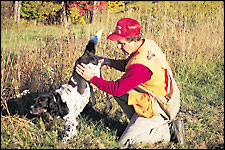 When the dog consistently points and settles into a good stance, put your hand in front of his face, telling him "whooaa." Soon you can face the dog near the planted bird and kick around in the grass as if trying to flush the bird for him. After a few minutes, do so. |
Repeat this a few days. You will now find that you have a truly staunch dog. You will be able to take your time to his points. Whistle blowing or talking will not cause him to move forward and flush the bird. Now that you have a staunch dog you have to decide if you want to use a beeper or bell. The dog will go on point and stay there until you find him or until the bird leaves. I have lost a dog on point for up to 20 minutes, only to find it tucked in a little pocket of brush still pointing its bird. Such a feat can make a day the most memorable of an entire season. A beeper will allow you to go right to the dog and flush the bird.
But since I am in no hurry and enjoy the suspense of searching for the dog, I still use bells, knowing he will be there waiting for me to flush and shoot his bird.






